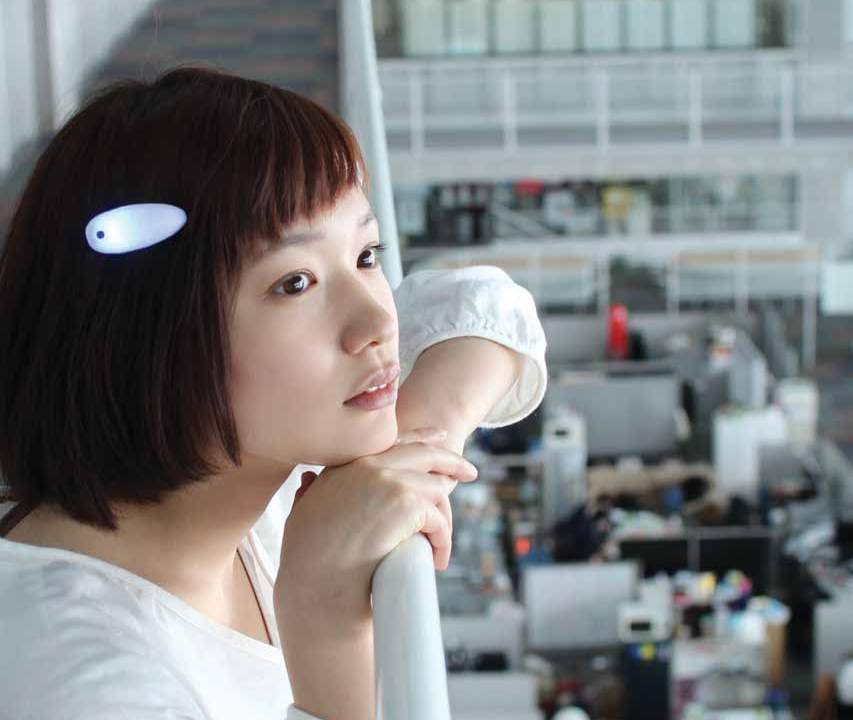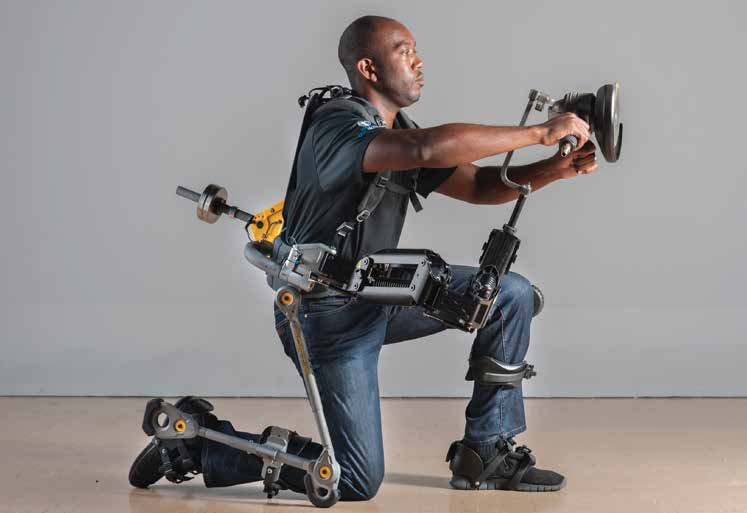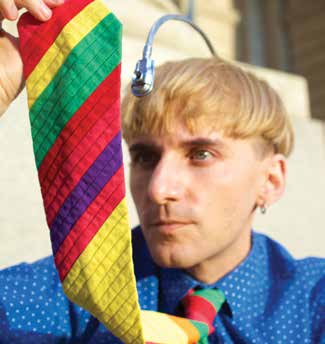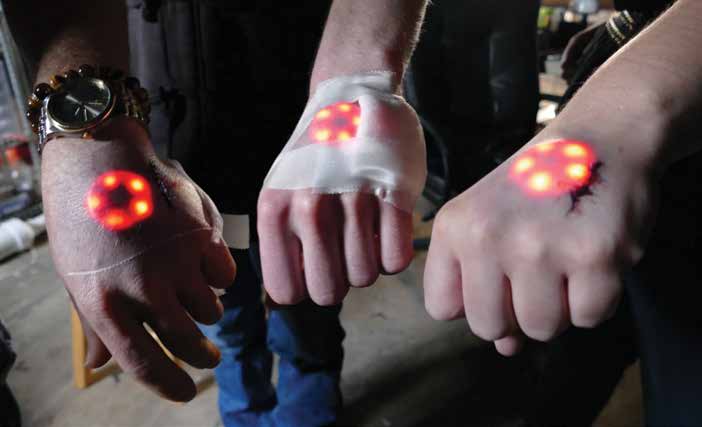
“If I could snap my fingers and be nonautistic, I would not. Autism is part of who I am.”—Temple Grandin
The year 2015 marked the 25th anniversary of the Americans with Disabilities Act (ADA), which banned discrimination against people with disabilities in employment, transportation, public accommodation, communications and government activities. This seems an apt time to explore how the next 25 years might unfold. Advocates call for an increased focus on cognitive accessibility, better access to information and communications, and more comprehensive treatment of the built environment. And we are experiencing a metamorphosis in how society views disability and how people with disabilities view themselves. But even as we struggle to create equity for all people in their diverse states, the terms of the challenge are about to change. Advances in technology—neurological interfaces, haptics, advanced prosthetics, gene editing—are expanding the spectrum of human physical, sensory and cognitive abilities. Museums, some of them already challenged to keep up with best practices in accessible design, are about More Than Human: extending the spectrum of ability to meet a new kind of visitor: people who experience the world in ways humans never have before.

Western culture has long conflated “average” with “normal,” stigmatizing people who stray too far from average and categorizing them as “other.” Physical and cognitive differences have at various times been interpreted as signs of divine disapproval, moral failing, genetic inferiority or, most recently, as conditions to be fixed or cured. The end of the last century saw the beginnings of a movement that challenges society to finally treat people with disabilities as simply people, deserving of the same rights and respect as the rest of the human race. The ADA was a victory for disability rights. Building on foundations laid by the universal design movement, the ADA promotes the creation of places and systems that are inherently accessible to a broad spectrum of people, regardless of age, condition or ability. More organizations, including museums, are realizing that accessible design is simply good design—simple, intuitive, flexible and equitable—even if examples of good, accessible design in practice are still distressingly rare. And starting with good design minimizes the circumstances in which additional modifications are needed to meet the needs of people with specific disabilities. The struggle to improve design is particularly important because many disabilities are, in effect, created by the built environment. (As the organization Little People of America points out, most achondroplastic adults can’t reach an automated teller machine. That’s a failing of the bank, not the customer.) Society categorizes people as disabled vs. nondisabled (or, as some people say, “temporarily abled”) and often treats disability as a condition that needs to be fixed. This concept is increasingly challenged by communities of people with different cognitive and physical abilities who view themselves and their peers as valid subcultures. “Deaf culture” has been explicitly recognized in the UN Convention on the Rights of Persons with Disabilities, and sign language is recognized as a distinct language, rather than an inferior work-around to “oralism.” The neurodiversity movement views autism as a valuable part of the human genetic legacy, cheering Temple Grandin’s declaration that people with autism are “different, not less.”
One logical outcome of this trend is the call to resist treating, or “curing,” some disabilities (see, for example, the debate regarding the ethics of cochlear implants, and whether this medical treatment can be viewed as an attempt to eliminate deaf culture). This issue becomes particularly fraught as advances in genetic screening and reproductive medicine give prospective parents more control over their future offspring. Sperm screening, in vitro fertilization, embryo selection and genetic testing can be harnessed to select for or against certain traits. We are only beginning the search for consensus, globally and nationally, on appropriate boundaries for these powers. Setting aside abortion per se (an issue unto itself), is it ethical for a parent to choose not to have a child who is autistic, or deaf, or has three copies of the 21st chromosome (resulting in Down Syndrome)? Stunning advances in gene editing—notably the recent discovery of CRSPR-Cas9—presage a future in which we can cut and paste pieces of genetic code into living organisms with astounding precision. Would using such technology to “cure” a child of a disability before birth simply be eugenics in 21st century garb?
Social movements that reject our urge to “fix” people are gaining strength just as we see a proliferation of technological tools designed to do exactly that. Wearable tech, in particular, is advancing in leaps and bounds, spawning “wearable assessment technology” and “smart glasses” that supplement low vision. Wearables like haptic vests and smart hairclips translate sound to vibration for the deaf and hard of hearing, and Google Glass can provide real-time captioning for conversations. Some of this technology is designed to be worn in rather than on the body, including digital tattoos and neural implants that enable people with paralysis to type and control devices with their brain waves.
We are rapidly moving beyond the realm of assistive technology, designed or people with disabilities, into augmentive technology that expands the boundaries of basic human capabilities. Once cochlear implants can function as “bionic ears” that can synch with wireless devices (remote microphones, TV streamers, phones), even people with average hearing may opt for elective surgery. Those haptic vests mentioned above work because our brains quickly learn to “transcode” vibrations into meaning. This transformation is effective for not only sound (and therefore speech) but also for any kind of data—remote sensors or EEG readings. A pilot, for example, could feed flight data directly into her body. Bionics can replace missing limbs, but also can help average runners attain the maximum speed of Usain Bolt (about 25 mph) on their own two feet. The inventor of the Bionic Boot is shooting for 40 mph. Robotic exoskeletons can not only enable someone who is paralyzed to walk, but enhance the speed and strength of any user. “Neuro-prosthetics” are being developed to compensate for brain injuries or aging. Could they be used to enhance memory overall?
Such augmentive devices lie at the heart of the Transhumanist movement, which is dedicated to transforming the human condition via technology. As the international nonprofit Humanity+ puts it, “we want people to be better than well.” This movement isn’t just about the far future—a growing cadre of biohackers, body hackers, grinders and cyborgs are experimenting on themselves now. The Grindhouse Wetware team has developed biometric implants and LED tattoos. People have slipped RFID chips under their skin, enabling them to unlock doors, start their cars, surf the Web and authenticate their credit cards via proximity or gesture. Neil Harbisson, artist and founder of the Cyborg Foundation, helped design an antenna that, planted in his skull, translates colors into vibrations he detects via bone conduction. Not content with limiting himself to the visible spectrum, he’s programmed the system to detect infrared and ultraviolet light, and tap into WiFi to monitor satellite data.

One forecast projects that a majority of humans will be “transhuman” by 2035, if you factor in mundane medical implants as well as new and emerging technology. All of which begs the question: When humans can choose to enhance their capabilities in these ways, what constitutes average, much less normal? And in an enhanced future, who will be considered “disabled”?
What This Means for Society
Cool advances in technology shouldn’t distract us from severe, persistent challenges, nationally and globally. In the US, only 17 percent of people with disabilities are employed (compared to over 64 percent of people without disabilities), and they earn significantly less than the nondisabled. Only 45 countries have anti-discrimination or other disability-specific laws.
Society has to work through the ethical and legal implications of our growing proficiency in genetic screening and gene editing. There is growing debate about the ethics of embryo editing. Currently, the editing of human embryos is banned in the US and the UK, but some are calling for these laws to be revised in order to facilitate research.
Sports, amateur and professional, are structured around rigid categories. What happens when these categories break down? We used to route athletes to the Paralympics so they wouldn’t be forced to compete with (and presumably lose to) people who don’t have disabilities. Now we face the opposite concern: When do prostheses that help competitors run faster or see better constitute an unfair advantage? Oscar Pistorius, a bilateral amputee and Paralympic champion who runs on highly advanced carbon-fiber prosthetics, was barred from the 2008 games when the Olympic Committee ruled against his “Cheetah” blades. He was allowed to compete in the 2012 games and didn’t medal, but how many elite, nondisabled athletes didn’t even make it that far? Our attempts to create “fair” categories for competition are already byzantine and increasingly untenable. (Can a woman with naturally high testosterone compete against other women?) Augmentation makes it exponentially harder to create level playing fields. And the fact that with augmentation, people with disabilities can outcompete people without disabilities may at last shake the perception that disability means “less than.”
More broadly, how might augmentation exacerbate inequality in society? When bionic arms can outperform the ones we are born with, might people choose to replace a healthy limb with robotics? What about people who don’t choose to become enhanced or can’t afford it? To the existing underclass of low SES (Socio-Economic Status) people, we may soon add BD (Biologically Disadvantaged). Though perhaps in a world where everyone is under pressure to be modified, nondisabled people who opt out of augmentation may learn to empathize with disabled people who resist being altered to conform to societal “norms.”
Museum Examples
One Saturday each month, the Pacific Science Center opens early for families with children with autism spectrum disorder. By dimming the lights, lowering the sound level and helping these visitors avoid crowds, the museum provides a welcoming environment for this segment of their community. (A number of other museums provide autism-friendly programs and visiting hours as well.)
Museum of Contemporary Art, Chicago provides Enchroma glasses to visitors upon request, enabling many people who are color-blind to experience color in some form. The museum also recently revamped its website with accessible design and incorporated multisensory cues into the galleries that enhance the experience of all users.
At the National Park Service’s Lowndes Interpretive Center, located along the Selma to Montgomery National Historic Trail in Alabama, statues illustrating the Civil Rights movement include one depicting Jim Letherer—a one-legged Jewish man who marched with Martin Luther King from Selma to Montgomery. As Day Al-Mohamed notes in a Museum article, “The exhibit is about the march and voting rights, but happens to have disability as part of the story—not because of any particular agenda, but because disability was there.”
What This Means for Museums
Museums can play a leadership role in society—as thought leaders, educators and ethicists—if they are willing to stand at the forefront of disability rights, rather than treading the narrowly legal trailing edge. This means not only integrating the principles of universal design into every aspect of their work, but integrating people with disabilities into their boards, staff and advisory groups.
Many museums, particularly smaller institutions and historic structures, are still working to meet the bar set by ADA. (Even many that have successfully tackled physical accessibility lag when it comes to communications—particularly wayfinding, interpretation for people with sensory or cognitive disabilities, and website design.) Museums need to prepare for the next wave of regulations, which will raise that bar.
Neil Harbisson describes how his cybernetic implant changes his experience of the visual world, including art. Significant numbers of people choosing to enhance and expand their senses would profoundly alter the experience of art and music created in a pre-augmentation era. How will augmented visitors experience art and other traditional museums? How will augmentation change the way we design exhibits and public spaces and create experiences?
Museums Might Want to…
- At a minimum, conduct a full audit of their physical and digital offerings for ADA compliance. “Minimum” because ADA standards should be considered the floor, not the ceiling, for accessibility. And it’s been proven over and over again that implementation of universal design improves the museum experience for all users—not just for people with disabilities. Such audits would benefit from the assistance of users with a variety of disabilities—to achieve this, museums might partner with local independent living centers as well as NGOs governed by people with disabilities.
- Be thoughtful about how people with disabilities are represented in interpretation. As Day Al-Mohamed wrote in a recent issue of Museum, “The ‘mechanical’ aspects of access to exhibits has overshadowed the importance of inclusion in museum content.” She goes on to encourage museums to recognize the “forgotten” disabilities of famous or powerful historical figures (Civil War photographer Matthew Brady, she points out, was totally blind by the end of his career) and to offer well-rounded portrayals of people with disabilities (here Al-Mohamed cites Helen Keller—who in addition to being an advocate for the blind, was a suffragist, a socialist, a pacifist
and a founder of the ACLU). - Explore the “hidden histories” of people with disabilities contained in the museum’s own collections. The UK report Buried in the Footnotes found that objects related to people with disabilities are “present in quantity” in most collections, but rarely displayed. The authors conclude such objects “give museums the potential to engage with and challenge the expectation that disability must equal a low contribution to society, by demonstrating how varied and potentially influential the roles of disabled people have been in the past.”

Additional Resources
In his TED talk “I Listen to Color,” Neil Harbisson shares the story of how he chose to become a cyborg. Born completely color-blind, he worked with scientists to design and implant an antenna in his skull that enables him to hear color. “The biggest change,” he notes “is going to an art gallery, I can listen to a Picasso, for example. So it’s like I’m going to a concert hall, because I can listen to the paintings.”
Released in 1997 (long before the discovery of CRISPR/Cas9 held out the promise of real-world gene editing), the scifi film GATTACA explored a future in which it is normal and expected for parents to use genetic engineering to create the best possible offspring. The story follows Vincent Freeman, a member of the “faith birth” underclass relegated to janitorial work, who refuses to accept his biological lot in life.
Some books of interest:
Graham Pullin, Design Meets Disability (The MIT Press, 2011). While a lot has happened in the four years since this book came out, Pullin’s discussion of how “design and disability can inspire each other” is still timely. Steve Silberman, NeuroTribes: the Legacy of Autism and the
Steve Silberman, NeuroTribes: the Legacy of Autism and the Future of Neurodiversity (Avery, 2015). In this exploration of the history of autism, Silberman profiles the neurodiversity movement, comprised of people seeking “respect, support, technological innovation, accommodations in the workplace and in education, and the right to self-determination for those with cognitive differences.”
Some of the articles that strongly influenced this chapter:
Zoltan Istvan, “Future Transhumanist Tech May Soon Change The Definition Of Disability.” TechCrunch, September 14, 2015.
Aimee Mullins, “Racing on Carbon Fiber Legs: How Abled Should We Be?” Gizmodo, November 12, 2009







